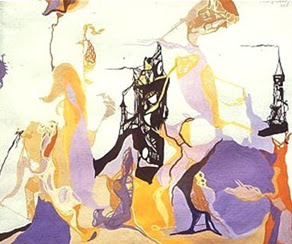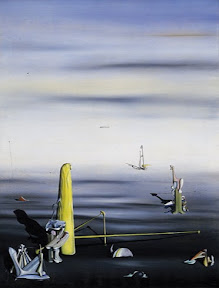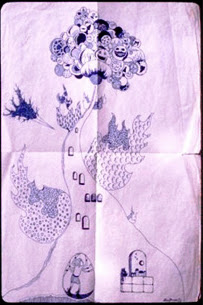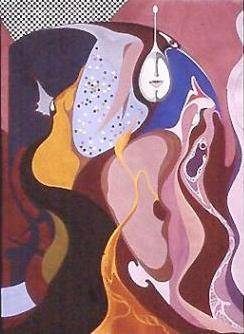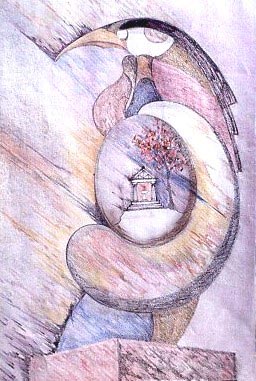In 1988 and 1989, I participated in the two Youth Art Competitions organized at the C.N.H. In both of them my pictures were prized.1
It was in 1989 that at work I met Noemí Suárez, who had studied art history like me.2 She once brought me her Dictionary of Symbols, so that I could have a look at it.
1 Dictionary of Symbols: Shields with hybrid motifs
On July 4th, 1989 my drawing Homage to the French Revolution was shown at the “Salon Bicentennaire de la Révolution Française” in Galerie d’Art La Porte Ouverte (Alliance Française de Buenos Aires, Centro Fortabat). This drawing is also known as “Minutos antes de la Revolución” (Some Minutes before the Revolution). It is characterized by the precarious balance of its Ledoux-inspired architecture.3
2 Mariano Akerman, Homenaje a la Revolución Francesa (Homage to the French Revolution), 1989
3 « Bicentennaire de la Révolution Française » Logo, July 1989
Andrea Gobbi, who had studied Architecture with me, suggested I might have an art show at the Bank of Boston Cultural Foundation. And so it was. Inaugurated in October 1989, “Ten Paintbrushes through Deep Waters” included new works such as Your Honour—A Real Lady, Three Figures by the Window, and The Way I love You.4
4 Mariano Akerman, Bank of Boston Cultural Foundation Poster, 1989
5 Mariano Akerman, Your Honour, Una Auténtica Lady (A Real Lady), 1989
6 Diario del Viajero, Buenos Aires, 11 October 1989, p. 1
7 Mariano Akerman, Tres a la Ventana (Three by the Window), 1989
Three by the Window was described by art critic Teresita Pociello as a work with a mobile structure recalling Miró.5 According to her, the final result of the picture is “americanista” (because it epitomizes the imaginative qualities born in the American continent).6
8Teresita Pociello, “Mariano Akerman,” Óleo y Mármol, Buenos Aires, 12-23 September 1989, p. 3
A reproduction of Miró’s Personage and Dog before the Sun (1949) was hanging in my bedroom as I was a child.7 Pociello did not know it though.
9 Joan Miró, Personage and Dog before the Sun, 1949
While I agree with Pociello’s observations, let’s add that Three by the Window was also a visual comment on Francis Bacon’s Three Studies for Figures at the Base of a Crucifixion (1944-45). That triptych was known to me via The Tate Gallery Illustrated Companion, a catalog my mother had brought to me from London in 1981.8
10 Tate Gallery Companion: Francis Bacon’s Three Studies for Figures at the Base of a Crucifixion, 1944-45
A colleague artist, Zulema Vaini, pointed out that I projected my inspiration in select images, giving my work the mysterious charm of things seldom seen by the human eye.9 Such words were a compliment. I think they do also apply to Odilon Redon.
11 Odilon Redon, Centaur, c. 1890s
Ten Paintbrushes through Deep Waters was inaugurated with special remarks by Bettina Sandrini: There is a precise and delicate line in his artwork. The fresh way in which he handles watercolor produces colorful results. As he depicts forms and details, his inner richness is expressed in terms of joy. In this way, his personages dream and grow up under skies specially created by him to convey a better world he aspires to. In a patient and silent distillation, he innovates in the visual arts.10
12 Mariano Akerman, ¡Cómo te quiero! (The Way I Love You), 1989
13 “Aguas Profundas,” El Cronista Comercial, Buenos Aires, 27 September 1989, sect. 2, p. 1
Crystalline was much celebrated as it was exhibited in the Italian Association of Buenos Aires. It was also shown in the Salon of Argentinean Painting in Galerías Pacífico, where it received a diploma in December 1989.11
Between February 1989 and May 1990, I was a member of the Latin-American Association of Artists and participated in twenty-two collective shows, ending my works often awarded.12 One of the jury’s favorites was Lots, Lots, Lots of Love.13 Its title was inspired by the last line of “The Gardener’s Song,” a great piece by Argentinean poetess and singer María Elena Walsh. 14
14 Mariano Akerman, Mucho, mucho, mucho amor (Lots, Lots, Lots of Love), 1989-90
In June 1990, my works were exhibited in three corners of Buenos Aires at the same time: Banco Mayo (Mariano Akerman: Continent and Content, 5-30 June 1990), Galería de las Golondrinas (Rupert) (Mariano Akerman and Erica Fabro, 7-27 June 1990), and Banco Federal Argentino (Mariano Akerman from Sun to Sun, 15-31 June 1990).15
15 Mariano Akerman, Banco Mayo Exhibition Poster, 1990
16 Mariano Akerman, Galería de las Golondrinas Exhibition Leaflet, 1990
In August 1990, Hilda Chanca from the John F. Kennedy University interviewed me. We talked about the limited opportunities Argentina had to offer to young artists then. I commented artists had fortunately learned how to extract water from rocks. She asked me whether the conjunction artist-architect was something unusual and I recalled Michelangelo, Le Corbusier, and Clorindo Testa. She also saw a possible link between animation and my artwork. I referred to Walt Disney, his talent and creativegenius.16 During the interview, I hinted at the illustrations of John Tenniel for Carroll’s literary work, which I had discovered in 1976.17
17 Hilda Chanca, “Un joven pintor,” Clubs & Countries Comunitarios, No. 15, September 1990
18 Mariano Akerman, Sacar agua de las piedras (To Extract Water from the Rocks), 1984-88
19 John Tenniel, Alice and Humpty Dumpty, 1872
The idea of including here an illustration of Humpty Dumpty is far from arbitrary, as one considers the kind of figures I was depicting in those days.
20 Mariano Akerman, Satisfacción (Satisfaction, see fig. 7)
21 Mariano Akerman, Raro peinado nuevo (New Strange Hairdo), 1990; 22 Mariano Akerman, Un giro moderno en mi sobriedad (A Modern Twist in My Sobriety), 1990
Because I liked Chanca very much, I took the initiative of making a special design for a study on the role of communication in the educational experience that she was going publish with one of her colleagues around that time.
23 Dolly Dolinsky and Hilda Chanca, Enseñanza-Aprendizaje: Una Experiencia Comunicacional, including Mariano Akerman, “Mandala” (1990), Buenos Aires: Universidad Argentina John F. Kennedy, 1990.
In October 1990, I had a new solo exhibit took place at the Art Gallery of Centro Cultural San Martín, one of the most important public venues in Buenos Aires.18 There, I included Lots, lots, lots of Love, The Messenger, In Movement, and Life Supporter (a tribute to Moroca, who had passed away not long before). A big automatism was also shown then. The Messengerand In Movement owed something to a globe in The Adventures of Baron Munchausen, the cinematic fantasy that was supposed to end all other fantasies.
24 Mariano Akerman, El mensajero (The Messenger), 1990
25 Still from The Adventures of Baron Munchausen (Columbia Pictures, 1988); 26 Mariano Akerman, En movimiento (In Movement), 1990
27 Mariano Akerman, Partidario de vivir (Life Supporter), 1990
Life Supporter shows a figure perhaps recalling Antoine de Saint-Exupéry’s Little Prince, except from the fact that mine stands accompanied not by a rose, but by a picture of the HIV virus (from Somos magazine). So far as I knew, Moroca had not died because of AIDS. However, when I was making this image, AIDS was the latest menace in Buenos Aires. That was an almost unbearable reality: Moroca was dead and there was AIDS all around. I depicted a Life Supporter holding a torch, as if trying toilluminate the world. This case in particular recalls an idea of Giordano Bruno: "the fictitious image contains its own truth."19
Writing from the National Museum of Fine Arts, Jorgelina Orfila indicated, "With secure hand and controlled drawing, a prolific imagination finds expression in his work. His technical knowledge intermingles with a profound introspection and an almost obsessive desire to transcend the formal and to convey deep meanings (the artist who is at once architect appears here)."20
28 Mariano Akerman, Automatismo “Para la Libertad” (Automatism), 1990
The San Martín Cultural Center catalog was designed echoing the scheme of PRIMER PLANO (foreground), a page which leading Buenos Aires newspaper La Nación devoted to a salient personality weekly. In including a portrait picture of one of my characters (Phoenix), my exhibition catalog became itself an invitation to consider an alternative possibility—Imagination.
29 Mariano Akerman, Centro Cultural San Martín Catalog, October 1990
The San Martín catalog included a telling epigraph of uncertain origin and some comments of my own. “What the tree has of flourished nourishes from that which is buried” (Lo que el árbol tiene de florido vive de aquello que tiene sepultado). This paradox was followed by a brief recollection of the circumstances relating to the emergence of my first abstract painting and reflections on the influence of Surrealism and Architecture on my work. Also indicated was the explanation that in order to create something I needed an inner oasis that can include a playful ingredient leading to fulfillment.21 The SanMartín exhibit was followed by three additional solo exhibits in Banco de la Provincia de Buenos Aires (Mariano Akerman: Paintings, 6-14 December 1990), ABN Bank Group (then Banco Holandés Unido, Mariano Akerman: Watercolors and Mixed Techniques, 17 December-31 January 1991), and Galería Saint Margaret (Mariano Akerman: Watercolors, 1-28 February 1991).22
30 Mariano Akerman, Banco de la Provincia de Buenos Aires Catalog, November-December 1990
A Sky of Projects was my solo art show at Galería Cinemateca S.H.A. in March 1991.23
31 Mariano Akerman, SHA Catalog, March 1991
The SHA exhibit included, among others, a picture with the very title of the show. A critic described this work as a mixture of figuration and abstraction, with a rich symbolism.24
32 Mariano Akerman, Cielo de proyectos (A Sky of Projects), 1990
The SHA exhibit was the culmination of the period usually referred to as "The Argentinean Years" (1963-1990). It was also the beginning of a wider horizon, one involving the spread of my artworks across three continents.
NOTES
1 Tigre, Club Náutico Hacoaj, Concurso de Pintura para Jóvenes Creadores, December 1988 and November 1989. The awarded pictures were Irreducible like Water and Lots, Lots, Lots of Love.
2 In 1988, I took the course “From Gauguin to Magritte: Reality, Abstraction and Fantasy in Contemporary Art” at the National Museum of Fine Arts, Buenos Aires. I was habitué there until 1991.
3 The designs of pre-Revolutionary architect Claude-Nicolas Ledoux fascinated me, particularly when studying the History of Architecture with Oscar Maisonave in 1986. Among my favorite architectural books, important was Christian Norberg-Schulz, Arquitectura occidental: la arquitectura como historia de formas significativas, Barcelona: Gili, 1985. Its chapter 10, “La Ilustración,” includes the imagery of Ledoux.
4 “Aguas profundas,” Cronista Comercial, 27 September 1989, sect. 2, p. 1; Diario del Viajero, year IV, no. 128, 11 October 1989: “Artes Plásticas;” Somos, 18 October 1989, p. 22: “Arte Crítica;” La Nación, 18 October 1989, sect. 3, p. 14.
5 While writing this, she possibly had in mind Miró’s The Harlequin’s Carnival of 1924 or Dutch Interior II of 1928 (H.H. Arnason, A History of Modern Art, London: Thames & Hudson, 1988, colorplates 126, 128).
6 “Mariano Akerman,” Óleo y mármol, Buenos Aires, 12-23 September 1989, p. 3.
7 Miró’s original tempera is in the Basel Kunstmuseum.
8 The Tate Gallery: An Illustrated Companion, ed. Norman Reid, London, 1979.
9 Vaini, quoted in Buenos Aires, Fundación Banco de Boston, Mariano Akerman, 18-27 October 1989.
10 Sandrini, Introductory words to Mariano Akerman’s Exhibit, 18 October 1989.
11 Buenos Aires, Asociación Italiana de Socorros Mutuos, 15 December 1989; Buenos Aires, Secretaría de Cultura de la Nación, Segundo Salón de Pintura Argentina para el Ámbito Nacional, 12-24 December 1989.
12 Each salon organized by A.L.A.P. (Asociación Latinoamericana de Artistas Plásticos) had its own catalog. Among my prized pictures were The Way I Love You (July 1989), We the Makers (June 1989),Crystalline (September 1989), Three by the Window (March 1990), and Lots, lots, lots of Love (October 1989 and May 1990).
13 This complex work was finished by October 1989; some of its details were reworked in early 1990.
14 “Canción del Jardinero” was known to me from her record Canciones para Mirar (Songs To Look At), which I had by the late 1960s. The song opens with a “Mírenme, soy feliz” (Look at me, I am happy). Its last lines are: “Yo no soy un gran señor / Pero en mi cielo de tierra / Cuido el tesoro mejor / Mucho, mucho, mucho amor” (I am not a big boss / But in my sky of earth / I take care ofthe best of treasures / Lots, lots, lots of love).
15 La Nación, 7 and 15 June 1990, sect. 3, p. 14: “Bellas Artes.”
16 I was always a fan of Disney’s movies. In 1986, after my first solo show took place, I traveled to Miami, where I bought a book on animation (Frank Thomas and Ollie Johnston, Disney Animation: The Illusion of Life, New York: Abbeville, 1984). By the time I was interviewed by Hilda Chanca I also had another one by the same authors (Too Funny for Words: Disney’s Greatest Sight Gags, New York: Abbeville,1987).
17 “Un joven pintor,”Clubs & Countries Comunitarios, No. 15, September 1990. I bought an illustrated exemplar of Carroll’s Alicia en el País de las Maravillas when I was thirteen (Punta del Este, 1976) and another one at the age of twenty-one (Buenos Aires, 1984).
18 La Nación, 6 October 1990, sect 3, p. 14: “Bellas Artes.”
19 Giordano Bruno, De vinculis in genere, 1591: “L’immagine fittizia ha la sua veritá.”
20 Buenos Aires, Centro Cultural General San Martín, Pasos, de Mariano Akerman, October 1990.
21 Ibid.
22 La Nación, 6 and 17 December 1990, sect. 3, p. 14; ” Clarín, 11 January 1991: “Galerías de Arte;” and La Nación, 4 February 1991, sect. 3, p. 14.”
23 La Nación, 9 March 1991, sect. 3, p. 14: “Bellas Artes.”
24 As had detected J.N. already in 1989 (The Buenos Aires Herald: Art).
It was in 1989 that at work I met Noemí Suárez, who had studied art history like me.2 She once brought me her Dictionary of Symbols, so that I could have a look at it.
1 Dictionary of Symbols: Shields with hybrid motifs
On July 4th, 1989 my drawing Homage to the French Revolution was shown at the “Salon Bicentennaire de la Révolution Française” in Galerie d’Art La Porte Ouverte (Alliance Française de Buenos Aires, Centro Fortabat). This drawing is also known as “Minutos antes de la Revolución” (Some Minutes before the Revolution). It is characterized by the precarious balance of its Ledoux-inspired architecture.3
2 Mariano Akerman, Homenaje a la Revolución Francesa (Homage to the French Revolution), 1989
3 « Bicentennaire de la Révolution Française » Logo, July 1989
Andrea Gobbi, who had studied Architecture with me, suggested I might have an art show at the Bank of Boston Cultural Foundation. And so it was. Inaugurated in October 1989, “Ten Paintbrushes through Deep Waters” included new works such as Your Honour—A Real Lady, Three Figures by the Window, and The Way I love You.4
4 Mariano Akerman, Bank of Boston Cultural Foundation Poster, 1989
5 Mariano Akerman, Your Honour, Una Auténtica Lady (A Real Lady), 1989
6 Diario del Viajero, Buenos Aires, 11 October 1989, p. 1
7 Mariano Akerman, Tres a la Ventana (Three by the Window), 1989
Three by the Window was described by art critic Teresita Pociello as a work with a mobile structure recalling Miró.5 According to her, the final result of the picture is “americanista” (because it epitomizes the imaginative qualities born in the American continent).6
8Teresita Pociello, “Mariano Akerman,” Óleo y Mármol, Buenos Aires, 12-23 September 1989, p. 3
A reproduction of Miró’s Personage and Dog before the Sun (1949) was hanging in my bedroom as I was a child.7 Pociello did not know it though.
9 Joan Miró, Personage and Dog before the Sun, 1949
While I agree with Pociello’s observations, let’s add that Three by the Window was also a visual comment on Francis Bacon’s Three Studies for Figures at the Base of a Crucifixion (1944-45). That triptych was known to me via The Tate Gallery Illustrated Companion, a catalog my mother had brought to me from London in 1981.8
10 Tate Gallery Companion: Francis Bacon’s Three Studies for Figures at the Base of a Crucifixion, 1944-45
A colleague artist, Zulema Vaini, pointed out that I projected my inspiration in select images, giving my work the mysterious charm of things seldom seen by the human eye.9 Such words were a compliment. I think they do also apply to Odilon Redon.
11 Odilon Redon, Centaur, c. 1890s
Ten Paintbrushes through Deep Waters was inaugurated with special remarks by Bettina Sandrini: There is a precise and delicate line in his artwork. The fresh way in which he handles watercolor produces colorful results. As he depicts forms and details, his inner richness is expressed in terms of joy. In this way, his personages dream and grow up under skies specially created by him to convey a better world he aspires to. In a patient and silent distillation, he innovates in the visual arts.10
12 Mariano Akerman, ¡Cómo te quiero! (The Way I Love You), 1989
13 “Aguas Profundas,” El Cronista Comercial, Buenos Aires, 27 September 1989, sect. 2, p. 1
Crystalline was much celebrated as it was exhibited in the Italian Association of Buenos Aires. It was also shown in the Salon of Argentinean Painting in Galerías Pacífico, where it received a diploma in December 1989.11
Between February 1989 and May 1990, I was a member of the Latin-American Association of Artists and participated in twenty-two collective shows, ending my works often awarded.12 One of the jury’s favorites was Lots, Lots, Lots of Love.13 Its title was inspired by the last line of “The Gardener’s Song,” a great piece by Argentinean poetess and singer María Elena Walsh. 14
14 Mariano Akerman, Mucho, mucho, mucho amor (Lots, Lots, Lots of Love), 1989-90
In June 1990, my works were exhibited in three corners of Buenos Aires at the same time: Banco Mayo (Mariano Akerman: Continent and Content, 5-30 June 1990), Galería de las Golondrinas (Rupert) (Mariano Akerman and Erica Fabro, 7-27 June 1990), and Banco Federal Argentino (Mariano Akerman from Sun to Sun, 15-31 June 1990).15
15 Mariano Akerman, Banco Mayo Exhibition Poster, 1990
16 Mariano Akerman, Galería de las Golondrinas Exhibition Leaflet, 1990
In August 1990, Hilda Chanca from the John F. Kennedy University interviewed me. We talked about the limited opportunities Argentina had to offer to young artists then. I commented artists had fortunately learned how to extract water from rocks. She asked me whether the conjunction artist-architect was something unusual and I recalled Michelangelo, Le Corbusier, and Clorindo Testa. She also saw a possible link between animation and my artwork. I referred to Walt Disney, his talent and creativegenius.16 During the interview, I hinted at the illustrations of John Tenniel for Carroll’s literary work, which I had discovered in 1976.17
17 Hilda Chanca, “Un joven pintor,” Clubs & Countries Comunitarios, No. 15, September 1990
18 Mariano Akerman, Sacar agua de las piedras (To Extract Water from the Rocks), 1984-88
19 John Tenniel, Alice and Humpty Dumpty, 1872
The idea of including here an illustration of Humpty Dumpty is far from arbitrary, as one considers the kind of figures I was depicting in those days.
20 Mariano Akerman, Satisfacción (Satisfaction, see fig. 7)
21 Mariano Akerman, Raro peinado nuevo (New Strange Hairdo), 1990; 22 Mariano Akerman, Un giro moderno en mi sobriedad (A Modern Twist in My Sobriety), 1990
Because I liked Chanca very much, I took the initiative of making a special design for a study on the role of communication in the educational experience that she was going publish with one of her colleagues around that time.
23 Dolly Dolinsky and Hilda Chanca, Enseñanza-Aprendizaje: Una Experiencia Comunicacional, including Mariano Akerman, “Mandala” (1990), Buenos Aires: Universidad Argentina John F. Kennedy, 1990.
In October 1990, I had a new solo exhibit took place at the Art Gallery of Centro Cultural San Martín, one of the most important public venues in Buenos Aires.18 There, I included Lots, lots, lots of Love, The Messenger, In Movement, and Life Supporter (a tribute to Moroca, who had passed away not long before). A big automatism was also shown then. The Messengerand In Movement owed something to a globe in The Adventures of Baron Munchausen, the cinematic fantasy that was supposed to end all other fantasies.
24 Mariano Akerman, El mensajero (The Messenger), 1990
25 Still from The Adventures of Baron Munchausen (Columbia Pictures, 1988); 26 Mariano Akerman, En movimiento (In Movement), 1990
27 Mariano Akerman, Partidario de vivir (Life Supporter), 1990
Life Supporter shows a figure perhaps recalling Antoine de Saint-Exupéry’s Little Prince, except from the fact that mine stands accompanied not by a rose, but by a picture of the HIV virus (from Somos magazine). So far as I knew, Moroca had not died because of AIDS. However, when I was making this image, AIDS was the latest menace in Buenos Aires. That was an almost unbearable reality: Moroca was dead and there was AIDS all around. I depicted a Life Supporter holding a torch, as if trying toilluminate the world. This case in particular recalls an idea of Giordano Bruno: "the fictitious image contains its own truth."19
Writing from the National Museum of Fine Arts, Jorgelina Orfila indicated, "With secure hand and controlled drawing, a prolific imagination finds expression in his work. His technical knowledge intermingles with a profound introspection and an almost obsessive desire to transcend the formal and to convey deep meanings (the artist who is at once architect appears here)."20
28 Mariano Akerman, Automatismo “Para la Libertad” (Automatism), 1990
The San Martín Cultural Center catalog was designed echoing the scheme of PRIMER PLANO (foreground), a page which leading Buenos Aires newspaper La Nación devoted to a salient personality weekly. In including a portrait picture of one of my characters (Phoenix), my exhibition catalog became itself an invitation to consider an alternative possibility—Imagination.
29 Mariano Akerman, Centro Cultural San Martín Catalog, October 1990
The San Martín catalog included a telling epigraph of uncertain origin and some comments of my own. “What the tree has of flourished nourishes from that which is buried” (Lo que el árbol tiene de florido vive de aquello que tiene sepultado). This paradox was followed by a brief recollection of the circumstances relating to the emergence of my first abstract painting and reflections on the influence of Surrealism and Architecture on my work. Also indicated was the explanation that in order to create something I needed an inner oasis that can include a playful ingredient leading to fulfillment.21 The SanMartín exhibit was followed by three additional solo exhibits in Banco de la Provincia de Buenos Aires (Mariano Akerman: Paintings, 6-14 December 1990), ABN Bank Group (then Banco Holandés Unido, Mariano Akerman: Watercolors and Mixed Techniques, 17 December-31 January 1991), and Galería Saint Margaret (Mariano Akerman: Watercolors, 1-28 February 1991).22
30 Mariano Akerman, Banco de la Provincia de Buenos Aires Catalog, November-December 1990
A Sky of Projects was my solo art show at Galería Cinemateca S.H.A. in March 1991.23
31 Mariano Akerman, SHA Catalog, March 1991
The SHA exhibit included, among others, a picture with the very title of the show. A critic described this work as a mixture of figuration and abstraction, with a rich symbolism.24
32 Mariano Akerman, Cielo de proyectos (A Sky of Projects), 1990
The SHA exhibit was the culmination of the period usually referred to as "The Argentinean Years" (1963-1990). It was also the beginning of a wider horizon, one involving the spread of my artworks across three continents.
NOTES
1 Tigre, Club Náutico Hacoaj, Concurso de Pintura para Jóvenes Creadores, December 1988 and November 1989. The awarded pictures were Irreducible like Water and Lots, Lots, Lots of Love.
2 In 1988, I took the course “From Gauguin to Magritte: Reality, Abstraction and Fantasy in Contemporary Art” at the National Museum of Fine Arts, Buenos Aires. I was habitué there until 1991.
3 The designs of pre-Revolutionary architect Claude-Nicolas Ledoux fascinated me, particularly when studying the History of Architecture with Oscar Maisonave in 1986. Among my favorite architectural books, important was Christian Norberg-Schulz, Arquitectura occidental: la arquitectura como historia de formas significativas, Barcelona: Gili, 1985. Its chapter 10, “La Ilustración,” includes the imagery of Ledoux.
4 “Aguas profundas,” Cronista Comercial, 27 September 1989, sect. 2, p. 1; Diario del Viajero, year IV, no. 128, 11 October 1989: “Artes Plásticas;” Somos, 18 October 1989, p. 22: “Arte Crítica;” La Nación, 18 October 1989, sect. 3, p. 14.
5 While writing this, she possibly had in mind Miró’s The Harlequin’s Carnival of 1924 or Dutch Interior II of 1928 (H.H. Arnason, A History of Modern Art, London: Thames & Hudson, 1988, colorplates 126, 128).
6 “Mariano Akerman,” Óleo y mármol, Buenos Aires, 12-23 September 1989, p. 3.
7 Miró’s original tempera is in the Basel Kunstmuseum.
8 The Tate Gallery: An Illustrated Companion, ed. Norman Reid, London, 1979.
9 Vaini, quoted in Buenos Aires, Fundación Banco de Boston, Mariano Akerman, 18-27 October 1989.
10 Sandrini, Introductory words to Mariano Akerman’s Exhibit, 18 October 1989.
11 Buenos Aires, Asociación Italiana de Socorros Mutuos, 15 December 1989; Buenos Aires, Secretaría de Cultura de la Nación, Segundo Salón de Pintura Argentina para el Ámbito Nacional, 12-24 December 1989.
12 Each salon organized by A.L.A.P. (Asociación Latinoamericana de Artistas Plásticos) had its own catalog. Among my prized pictures were The Way I Love You (July 1989), We the Makers (June 1989),Crystalline (September 1989), Three by the Window (March 1990), and Lots, lots, lots of Love (October 1989 and May 1990).
13 This complex work was finished by October 1989; some of its details were reworked in early 1990.
14 “Canción del Jardinero” was known to me from her record Canciones para Mirar (Songs To Look At), which I had by the late 1960s. The song opens with a “Mírenme, soy feliz” (Look at me, I am happy). Its last lines are: “Yo no soy un gran señor / Pero en mi cielo de tierra / Cuido el tesoro mejor / Mucho, mucho, mucho amor” (I am not a big boss / But in my sky of earth / I take care ofthe best of treasures / Lots, lots, lots of love).
15 La Nación, 7 and 15 June 1990, sect. 3, p. 14: “Bellas Artes.”
16 I was always a fan of Disney’s movies. In 1986, after my first solo show took place, I traveled to Miami, where I bought a book on animation (Frank Thomas and Ollie Johnston, Disney Animation: The Illusion of Life, New York: Abbeville, 1984). By the time I was interviewed by Hilda Chanca I also had another one by the same authors (Too Funny for Words: Disney’s Greatest Sight Gags, New York: Abbeville,1987).
17 “Un joven pintor,”Clubs & Countries Comunitarios, No. 15, September 1990. I bought an illustrated exemplar of Carroll’s Alicia en el País de las Maravillas when I was thirteen (Punta del Este, 1976) and another one at the age of twenty-one (Buenos Aires, 1984).
18 La Nación, 6 October 1990, sect 3, p. 14: “Bellas Artes.”
19 Giordano Bruno, De vinculis in genere, 1591: “L’immagine fittizia ha la sua veritá.”
20 Buenos Aires, Centro Cultural General San Martín, Pasos, de Mariano Akerman, October 1990.
21 Ibid.
22 La Nación, 6 and 17 December 1990, sect. 3, p. 14; ” Clarín, 11 January 1991: “Galerías de Arte;” and La Nación, 4 February 1991, sect. 3, p. 14.”
23 La Nación, 9 March 1991, sect. 3, p. 14: “Bellas Artes.”
24 As had detected J.N. already in 1989 (The Buenos Aires Herald: Art).

